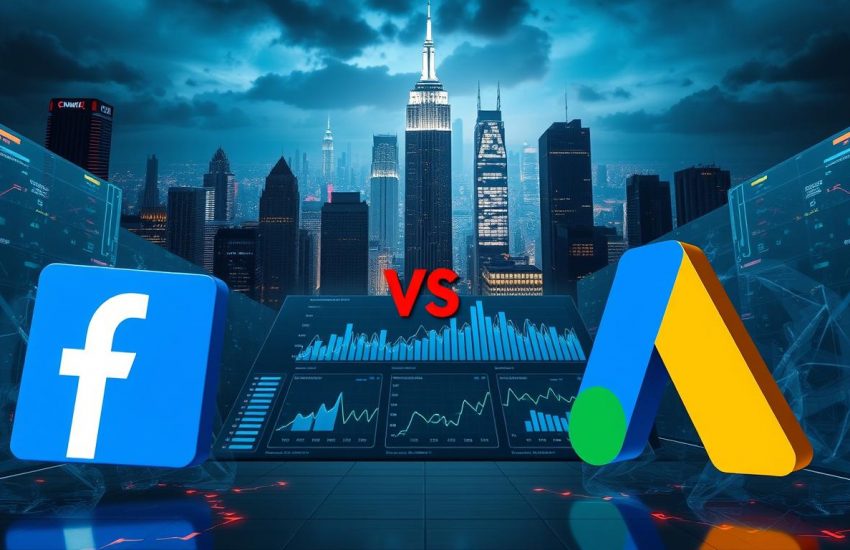Surprising fact: billions of daily searches meet billions of monthly social users — and that scale is shaping where businesses win or waste budget.
We set the stage by comparing two dominant advertising ecosystems. Our aim is clear: help you match goals to the right platform. We explain when search intent beats discovery, and when social storytelling drives demand.
In 2025, the smartest route is rarely either/or. We recommend aligning objectives, creatives, and tracking to user context. That reduces wasted spend and improves measurable ROI.
Quick preview: google ads captures users actively searching for solutions. facebook ads creates awareness, nurtures consideration, and powers retargeting at lower CPCs.
Read on for a practical framework you can apply to campaigns. You’ll learn which platform to prioritize by goal, industry, and budget stage — and how to use both together for compounding performance.
Key Takeaways
- Match search-driven moments to search campaigns for higher intent.
- Use social feeds for discovery, brand awareness, and creative testing.
- Align objectives and creatives with user context to cut wasted spend.
- Blend short-term conversions with long-term brand building to lower CAC.
- Update measurement and attribution to reflect privacy and GA4 changes.
Understanding 2025 buyer behavior and ROI expectations in the United States
Consumers now split time between purposeful search and scrolling, and that split shapes results.
Search pulls people who are actively searching for solutions. These users often convert faster. For service-based and high-ticket business, that speed can justify higher bids and immediate ROI.
Discovery pushes happen during downtime across social surfaces. Reach and creative variety lower the average click cost. But the path to purchase takes longer as audiences move from awareness to consideration.

- In 2025, U.S. users expect relevant messages that respect privacy and context.
- Buyer journeys are multi-touch; audiences warmed on social often convert later in search.
- Expect signal loss from privacy updates — invest in GA4, server-side tracking, and clear conversion taxonomy.
- Align roles: seed demand on social, harvest demand where customers search, then retarget across both.
Reporting tip: set stage-based benchmarks. Track early engagement metrics for social and last-click revenue for search. Treat attribution as directional and use blended ROAS to see true cross-channel impact on your goals.
Paid search vs. paid social: how the platforms fundamentally differ
Paid search and paid social operate on different assumptions about user intent and timing. We should pick the right channel based on whether you need immediate answers or long-term awareness.
User intent: The search engine catches people who are actively searching. When someone types a query, keywords and match types determine if your search platform ad appears. That moment often signals higher purchase intent and faster conversions.

Discovery and audience: Paid social surfaces your message in feeds. You target by demographics, interests, and behaviors to reach an audience before they make searches. This drives awareness and scales reach among similar profiles.
- Placements: Search, Display Network, and YouTube extend reach beyond queries.
- Feed placements: Platforms include Instagram, Messenger, and Audience Network for visual-first storytelling.
- Creative approach: Use utility-driven text for SERPs; use motion and storytelling in feeds.
Both systems run auction-based PPC and offer retargeting. The lesson is simple: match KPIs to context—measure search for intent-driven conversions and paid social for discovery metrics and later funnel influence.
What actually drives ROI: cost, intent, conversion speed, and measurement
ROI comes down to three simple forces: cost per interaction, user intent, and how quickly that interest becomes revenue.
Cost dynamics and CPC benchmarks across industries and placements
Cost varies by industry. Finance and insurance often exceed $5 per click, with legal and roofing among the most expensive search terms. By contrast, social feed placements typically report lower median CPCs — roughly $0.29 to $1.89 by industry.
High intent vs. low intent: impact on conversion rates and time to results
High-intent search traffic converts faster. That makes higher bids on google ads justifiable for service-based and high-ticket categories.
Lower-cost social placements help you build demand and retarget. But conversion usually needs multiple touches, so time to results is longer.
Tracking and attribution in 2025: privacy shifts, GA4, pixels, and blended ROAS
Measurement is the third lever. Privacy updates and incomplete pixel data force teams to adopt GA4, server-side modeling, and blended ROAS for true cross-channel visibility.
“Hard data plus modeled conversions give you the confidence to invest where it moves the business.”
We recommend testing creative and offer on social, then capturing intent with precise query coverage on search. Manage budget by funnel stage: early-stage CPM-efficient spend, bottom-funnel dollars on high-intent terms.
- Quick checklist: track LTV and payback period, use blended attribution, and pair ads google investments with remarketing across display and video to compound performance.
Google Ads advantages and trade-offs for performance-focused campaigns
When performance matters, the search ecosystem is built to capture customers at the moment they decide. We rely on that immediacy when ROI is the priority.
Strengths
Reach and intent: Google processes billions of daily queries across search, display, YouTube, and Shopping formats. That scale helps you meet users at high-intent moments.
- Keyword precision: Target branded, category, and competitor searches to intercept high-value searches.
- Shopping Ads: Showcase product image, price, and ratings for strong transactional CTRs.
- Remarketing: Use display network and video to re-engage cart abandoners and evaluators.
Challenges
Expect higher CPCs in competitive verticals like legal and finance. Setup and optimization can be complex.
Invalid clicks and bot traffic add risk. We recommend strict negative keywords, automated exclusions, and conversion-based optimizations to protect your budget.
“Hard data plus modeled conversions give you the confidence to invest where it moves the business.”
| Format | Primary Use | Benefit | Key Risk |
|---|---|---|---|
| Search | Direct response | High intent, clear ROI | High CPCs in competitive niches |
| Shopping | Product capture | Improved CTR on transactional queries | Feed complexity, price competition |
| Display / YouTube | Remarketing & awareness | Cross-site reach and re-engagement | Lower intent, creative dependency |
Facebook Ads advantages and trade-offs for brand awareness and audience growth
For brand builders, feed-based platforms excel at turning casual attention into interest. We use these channels to seed awareness and scale audiences before people search.
Strengths: precise targeting and visual formats
Advanced audience targeting lets you define people by demographics, interests, and behaviors. Lookalikes expand reach to profiles similar to your best customers.
Visual formats — single image, video, carousel, collection — drive engagement and help build brand awareness at lower CPCs than search. Dynamic creative speeds testing and scale.
Challenges: intent, fatigue, and signal loss
Users in feeds usually show lower purchase intent. Expect longer paths to conversion and plan multi-touch follow-up that moves audiences toward search and remarketing.
Ad fatigue is real. Rotate creatives, change hooks, and cap frequency to protect performance. Also strengthen event quality and use modeled conversions to offset tracking limits from iOS and cookie changes.
“Treat these campaigns as the engine of awareness that feeds lower-funnel capture.”
Targeting, formats, and creative: matching your message to each platform
Your message wins when the creative, format, and target line up with user intent. Start by choosing the right targeting and format for each stage of the funnel.
Google options: search, display, YouTube, Shopping, Performance Max
google ads spans Search, Shopping, YouTube, Display, and Performance Max for cross-network coverage. Search and shopping ads capture high intent.
Use Display and YouTube for awareness and retargeting; Performance Max for automated reach while keeping exact-match campaigns for control.
Facebook options: single image/video, carousel, Collection, Dynamic Product Ads
facebook ads formats drive visual engagement. Single image or video speeds testing. Carousel and Collection invite exploration.
Dynamic Product Ads personalize retargeting by showing items people viewed. Sync your product feed to keep price and availability accurate.
Creative strategy: text-first efficiency vs. highly visual storytelling
- Targeting fundamentals: use intent and query context on search and demographic, behavioral, and interests signals in feeds.
- Match options to objectives: capture with Search and Shopping; scale with Display and YouTube.
- Test and transfer: find winning hooks on social, then mirror top copy in responsive search assets.
“Translate brand pillars into platform-native creative and document learnings in a shared playbook.”
Costs and CPC in 2025: how budget, industry, and placement affect performance
Cost per click now depends as much on placement and competition as on creative quality. That means your budget choices must reflect industry pressure and campaign stage.
Google Ads CPC nuances
High-pressure categories—legal, finance, and home services—regularly push median CPCs above $5. These verticals demand more budget and tighter keyword management.
Lower-cost niches like apparel and restaurants often show better efficiency. A notable google ads campaign for an eye care group returned 372,000 impressions, 22,820 clicks, and a 15.07% conversion rate. That illustrates how intent can justify higher bids.
Facebook Ads CPC nuances
Feed placements usually cost less per click. Benchmarks range from about $0.17 in travel to $1.89 in storage and moving. Instagram inventory tends to be pricier than native feed spots.
- Set budget by competitive pressure and stage.
- Evaluate click economics with conversion rate, not CPC alone.
- Allocate for stage: new brands 60–70% to social awareness and 30–40% to search and retargeting; established brands flip toward search capture.
| Placement | Typical CPC | Best use |
|---|---|---|
| Search (branded/non‑brand) | $0.50–$10+ | Bottom‑funnel capture, high intent |
| Feed / Social | $0.17–$1.89 | Awareness, audience building |
| Instagram / Premium Feed | $0.60–$2.00 | Visual creative, higher CTR potential |
“A higher CPC can still win if intent is strong and funnel friction is low.”
Facebook Ads vs Google Ads: choosing the right platform for your goals
Start with what you need today: immediate conversions or long-term brand growth. That single decision should shape your platform allocation and creative approach.
Objective-led selection: conversions now vs. brand awareness and audience building
If you need conversions now, favor google ads for bottom-funnel capture. Search meets users with clear intent and short time to purchase.
If you need brand and audience growth, favor facebook ads to seed awareness, test creative, and build a warm audience for later retargeting.
Industry lens: service-based and high-ticket vs. lifestyle and impulse-friendly brands
Service-based and high-ticket businesses usually show better ROI on google ads. Users search with urgency and buy faster.
Lifestyle and impulse-friendly brands compound on facebook ads. Visual storytelling and community drive discovery and repeat customers.
Budget stage: new launches, established brands, and balancing remarketing
New launches often allocate ~60–70% to facebook ads and 30–40% to google ads. That seeds demand while capturing ready buyers for immediate revenue.
Established brands invert the split: more budget to Search and Shopping, with social kept for creative testing and retargeting.
“Social introduces and informs; search closes. Blend both and measure with blended ROAS.”
| Stage | Primary Focus | Suggested Split | Key Tool |
|---|---|---|---|
| New launch | Awareness & list building | 60–70% social / 30–40% search | GA4, Triple Whale |
| Growth / established | Capture & scale revenue | 60–70% search / 30–40% social | Northbeam, blended ROAS |
| Always-on | Retargeting & testing | Balanced; optimize quarterly | Server-side tracking |
- Define platform-native KPIs: engagement and audience growth for awareness; revenue and qualified leads for capture.
- Use audience insights to tailor messaging: clear pain points for searchers; value-driven stories for scrollers.
- Measure across tools (GA4, Northbeam, Triple Whale) to avoid over-crediting any single touch.
Conclusion
To maximize ROI in 2025, treat each platform as a role player in a broader funnel. Both platforms bring scale and specialty: google ads captures intent, while social channels seed interest. Orchestrate them so each channel does what it does best.
Use google ads to win high-intent moments like product queries and purchase-ready search. Use facebook ads to build awareness, test creative, and warm audiences for later capture.
Anchor your plan in clear roles, platform-native KPIs, and agile testing. Right-size budgets by stage and expand retargeting as traffic grows. Keep creative disciplined on search and expressive on social so messaging matches mindset.
We recommend strengthening measurement with GA4 and blended ROAS, mapping objectives to channels, and optimizing for lifetime value — not just last-click.


